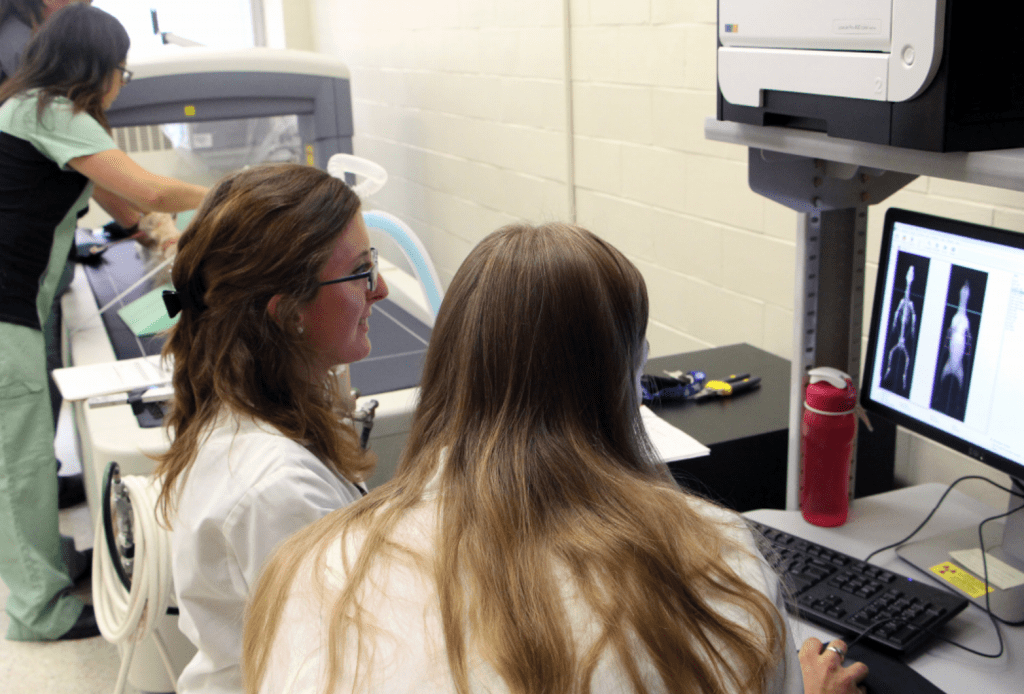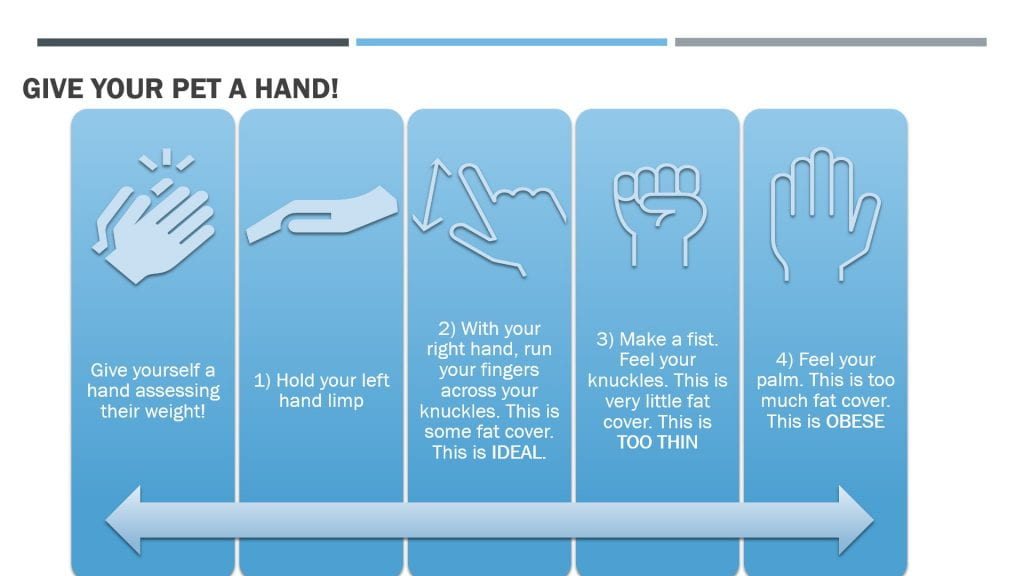It has been reported that approximately 59% of dogs and cats are overweight or obese1. It’s not about appearances, as excess body fat decreases a pet’s quality and length of life, while increasing the risk of chronic illness and injury.2-4 One lifetime study demonstrated that overweight dogs lived almost two years less, and with a greater incidence of disease at a younger age than their healthy peers2-4. A little extra weight can make a big difference for pets!
October is National Pet Obesity Awareness Month, so it seems fitting to explore a tool universally used by veterinary healthcare teams to assess the weight health of pets.
What is Body Condition Scoring?
Body Condition Scoring is a standardized method to estimate a patient’s body fat percentage and assess if they carry a healthy, excessive, or inadequate amount of body fat. These scores will allow the veterinary healthcare team to determine the approximate ideal body weight of the patient if they are assessed as underweight or overweight.
This system relies on several visual cues in combination with various regions of the body that are palpated (medically examined through touch) to assess the degree of fat cover.
Why me?
Barring unforeseen challenges, the veterinary healthcare team only assesses pets every 6-12 months. The rest of the year, the pet’s care-provider is monitoring the health of their pets. Learning this system allows pet’s families to help monitor weight health throughout the year. If any changes are noted, they can give the veterinary healthcare team an early warning about brewing disease or malnutrition. Early intervention may allow for better treatment and may even prevent some diseases!
It’s Not a Matter of Opinion
This system is scientifically validated5, 6, whether a lean Siamese or stocky bulldog. A cat is not a small dog, and a dog is not a small horse, so be sure to utilize a species-specific system!
The gold standard of assessing body composition in patients is via DEXA, Dual-Energy X-ray Absorptiometry. This technology uses a very low dose of radiation to scan the body via a moving arm. With computer analysis, the scanned information is utilized to quantify body tissue types. For example, it will evaluate how much of the patient is fat, lean tissue (muscle, organs, etc.), and bone. Although also used in metabolic purposes in human medicine, the most common use is in monitoring bone composition, also known as a, “bone density scan”. These machines are unfortunately very large and expensive, so not available to family veterinary teams. However, the body condition scoring system used by veterinary healthcare teams was developed and validated with this technology. When performed correctly, BCS is a validated health monitoring tool5,6.

The Body Condition Score
The standard BCS system is based on a 9-point scale, shown below for each dogs and cats. Cats are deemed to be healthy with a BCS of 5/9, while 4 or 5 is considered healthy for dogs. Each point above 5 represents an additional 10-15% body fat.
The Numbers
| Details | 1/9 | 2/9 | 3/9 | 4/9 | 5/9 | 6/9 | 7/9 | 8/9 | 9/9 |
|---|---|---|---|---|---|---|---|---|---|
| % Fat | <5 | 5 | 10 | 15 | 20 | 25 | 30 | 35 | >40 |
| Term | Emaciated | Thin | Thin | K9 HEALTHY Cats Thin | HEALTHY | Over- weight | Over- weight | Obese | Obese |


Looking Healthy
With the pet standing, facing forward, visually assess:
1) The pet’s shape from above
- Dogs: A hourglass curve should be evident between the ribcage and the hips. You may appreciate the last rib or two
- Cats: Should display a slight inward curve but will not be as defined as dogs. A lack of an inward curve, or outward curve, the cat is likely overweight.
2) The pet’s shape from the side
- In dogs, a defined abdominal tuck should be present behind the ribs, before the hips. The degree of tuck will vary between breeds. Dee-chested dogs should display a marked abdominal tuck.
- Some abdominal tuck may still be present if overweight or obese
- An absence of an abdominal tuck, or an outward curve, may be present in an obese patient
- An abdominal tuck in cats may be too thin.
In cats – assess the abdominal fat pad
- Many previously obese cats will have a pouch of loose skin. There should be a minimal layer of fat here. More, and the cat may be overweight or obese. This is a visual and tactile assessment.
Bones beneath the skin
- Ribs:
- Visualization of the ribcage is healthy!
- In dogs, visualizing 1-2 individual ribs is healthy. More may be visible is the pet is sniffing or moving around the room, or if very short haircoat.
- In cats, visualizing ribs is too thin
- Hip-bones- if visualized, patient is too thin, 3/9 or less
- Spine – if visualized, patient is too thin, 3/9 or less
- Any other bones evident under the skin may be present if the pet is too thin or is losing muscle mass.
If you think your pet is not a healthy body condition, reach out to your veterinary healthcare team for guidance.
Supporting Videos:
Shoshana: Hello everyone, my name is Shoshana, I’m a Clinical Nutrition Veterinary Technician, and I’m here to show you how to do a one-minute body condition score with my dog Kina. What we’re going to do is we’re going to first visualize their body condition score from the side. What I’m looking for here is a nice, clearly defined abdominal tuck right behind the rib cage and right before the pelvis in the inguinal area and what I want to see in a deep-chested German Shepherd is an associated deeply defined abdominal tuck with no fat pad here.
Shoshana: You want to see a nice clear hourglass shape right behind the rib cage here and if you see one or two ribs from the top, that’s okay. Even with the thick coat, I want to have a nice clear curve in here and then right before the pelvis a nice clear defined hourglass. I’m going to use that in combination with feeling the rib cage, so I’ve put my fingers right up against the skin under the hair coat, even a dense hair coat, and I’m feeling just the amount of fat that’s covering the ribs.
Give Yourself a Hand
The other important component of the body condition assessment is palpation over the ribcage.
Assess down the pet’s ribcage from head to tail, feeling for fat covering the ribs. Fat deposits commonly around the upper third of the ribcage, so the author finds it helpful to consider assessment in this region. To do so, imagine the pet’s ribcage as a clock-face, with the spine at 12:00, and their breastbone at 6:00. Palpate at 10:00 and 2:00.
What does healthy feel like? Give yourself a hand and follow this exercise!

1) Hold your left hand limp.
2) With your right hand, feel the bones on the back of your hand. THIS IS IDEAL. Just slight fat covering.
3) Make a fist with your left hand.
4) Feel your knuckles with your right hand. THIS IS TOO THIN. Very little fat covering.
5) Flip your left hand over, holding it limp.
6) With your right hand, feel your palm. Notice how you need to push harder to feel the bones of your left hand? THIS IS OVERWEIGHT.
What Should I Do Next?
If the above assessment seems to indicate that the pet’s body condition is above or below a healthy 4-5/9, seek veterinary guidance. Do not attempt to change activity, food, feeding amount, or the feeding routine without the guidance of the veterinary healthcare team.
If the pet is at a healthy body condition, congratulations to the caregiver! This vital parameter is healthy and can be included as part of the patient’s overall assessment. Continue to monitor weekly as part of the pet’s normal grooming routine.
Disclaimer
The above is provided for educational purposes only, and should not replace a physical exam, consultation, or diagnosis by a veterinarian. The above may be utilized as a resource only. For more information and clarity, the above should be reviewed with the veterinary healthcare team and integrated into the health monitoring of pets. Care providers should not change their pet’s treatment, food, or feeding amount without first consulting with their veterinary healthcare team.
Written by Shoshana Verton-Shaw, RVT, VTS (Nutrition)
Edited by:
Dr. Erico Ribeiro, MV, PhD, DVSc Student, ECVCN Resident
Dr. Francisco Poblanno Silva, DVM, DVSc Student, ECVCN Resident
Dr. Adronie Verbrugghe, DVM, PhD, EBVS Specialist in Veterinary and Comparative Nutrition® (Dip ECVCN)
References
1. Bomberg, E., Birch, L., Endenburg, N., German, A. J., Neilson, J., Seligman, H.,…Day, M. J. (2017). The financial costs, behavior and psychology of obesity: A one health analysis. Journal of Comparative Pathology, 156(4), 310–325. doi:10.1016/j.jcpa.2017.03.007
2. Kealy, R. D., Lawler, D. F., Ballam, J. M., Mantz, S. L., Biery, D. N., Greeley, E. H.,…Stowe, H. D. (2002). Effects of diet restriction on life span and age-related changes in dogs. Journal of the American Veterinary Medical Association, 220(9), 1315–1320. doi:10.2460/ javma.2002.220.1315
3. Lund, E. M., Armstrong, P. J., Kirk, C.A., & Klausner, J. S. (2006). Prevalence and risk factors for obesity in adult dogs from private US veterinary practices. Journal of Applied Research and Medicine, 4(2), 177–186.
4. Lawler, D. F., Larson, B. T., Ballam, J. M., Smith, G. K., Biery, D. N., Evans, R. H.,…Kealy, R. D. (2008). Diet restriction and ageing in the dog: Major observations over two decades. British Journal of Nutrition, 99(4): 793–805. doi:10.1017/S0007114507871686
5. Mawby D, Bartges JW, Moyers T, et. al. Comparison of body fat estimates by dual-energy x-ray absorptiometry and deuterium oxide dilution in client owned dogs. Compendium 2001; 23 (9A): 70
6. Laflamme DP. Development and Validation of a Body Condition Score System for Dogs. Canine Practice July/August 1997; 22:10-15


